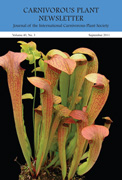International Carnivorous Plant Society
Carnivorous Plant Newsletter Archive
Natural abundance of stable isotopes reveals the diversity of carnivorous plant diets
Brearley, Francis Q.
Carniv. Pl. Newslett. 40(3):84-87
Published 1 September 2011
https://doi.org/10.55360/cpn403.fb708
Abstract
Ever since carnivorous plants were first described and studied by early naturalists (e.g., Darwin 1875), there has been continued interest in the relationship between the uptake of nutrients from invertebrate prey and the growth and performance of these plants. Although it is now thought that multiple nutrients appear to limit the growth of most carnivorous plants (Ellison 2006), of particular interest has been nitrogen (N), as many studies have shown that carnivorous plants can obtain extra N from the digestion of their prey.
Keywords: carbon, Cephalotus, Dionaea, Drosera, Nepenthes, nitrogen, nutrients, Roridula, stable isotopes
Article Citation
Brearley, Francis Q.. 2011. Natural abundance of stable isotopes reveals the diversity of carnivorous plant diets. Carniv. Pl. Newslett. 40(3):84-87. https://doi.org/10.55360/cpn403.fb708
Page views: 886
©2025 International Carnivorous Plant Society
www.carnivorousplants.org
This page is maintained by John Brittnacher.
Please contact us at our membership website, icps.clubexpress.com.
Privacy: The Carnivorous Plant Newsletter Archive website does not track users.

